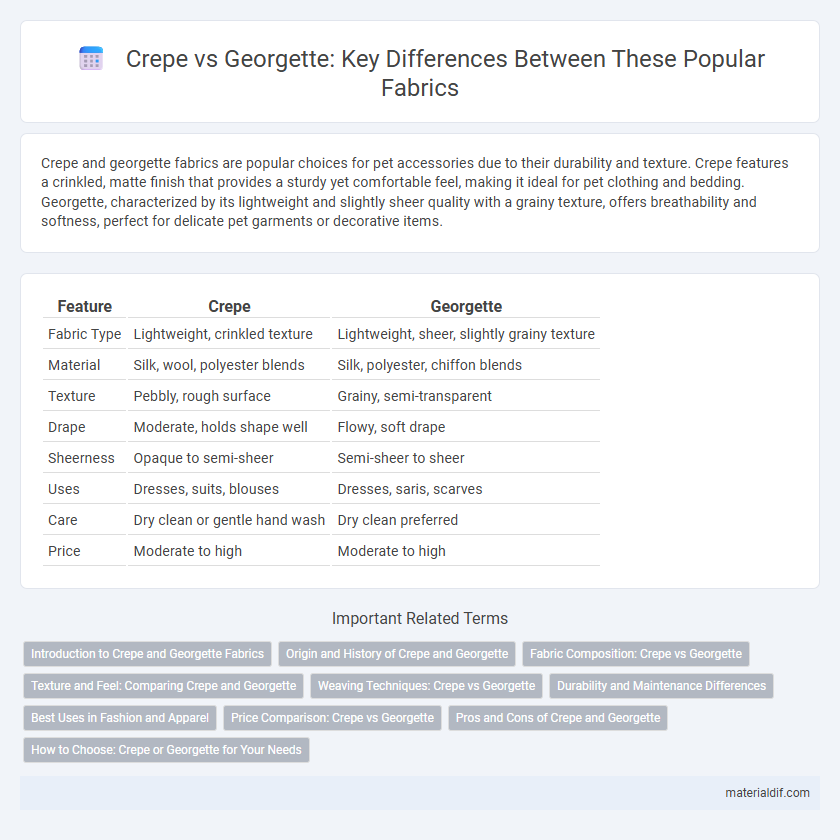Crepe and georgette fabrics are popular choices for pet accessories due to their durability and texture. Crepe features a crinkled, matte finish that provides a sturdy yet comfortable feel, making it ideal for pet clothing and bedding. Georgette, characterized by its lightweight and slightly sheer quality with a grainy texture, offers breathability and softness, perfect for delicate pet garments or decorative items.
Table of Comparison
| Feature | Crepe | Georgette |
|---|---|---|
| Fabric Type | Lightweight, crinkled texture | Lightweight, sheer, slightly grainy texture |
| Material | Silk, wool, polyester blends | Silk, polyester, chiffon blends |
| Texture | Pebbly, rough surface | Grainy, semi-transparent |
| Drape | Moderate, holds shape well | Flowy, soft drape |
| Sheerness | Opaque to semi-sheer | Semi-sheer to sheer |
| Uses | Dresses, suits, blouses | Dresses, saris, scarves |
| Care | Dry clean or gentle hand wash | Dry clean preferred |
| Price | Moderate to high | Moderate to high |
Introduction to Crepe and Georgette Fabrics
Crepe fabric is known for its distinctive crinkled texture and matte finish, often made from silk, wool, or synthetic fibers, offering a soft yet structured drape ideal for formal wear. Georgette, a lightweight, sheer fabric traditionally made from silk or polyester, features a slightly rough texture with a flowing, airy quality perfect for dresses and blouses. Both fabrics are prized for their unique textures and elegant appearance, widely used in fashion for their versatility and comfort.
Origin and History of Crepe and Georgette
Crepe fabric originated in the early 19th century, with roots tracing back to French silk weaving techniques characterized by its crinkled texture created through tightly twisted yarns. Georgette, named after the French dressmaker Georgette de la Plante in the early 20th century, evolved as a lightweight, sheer fabric made from silk or synthetic fibers, valued for its flowy drape and slightly rough surface. Both fabrics hold significance in textile history, with crepe traditionally used in formal attire and mourning garments, while georgette became popular for elegant evening wear and blouses.
Fabric Composition: Crepe vs Georgette
Crepe fabric is typically woven from silk, wool, or synthetic fibers, characterized by its crinkled or pebbled texture created through twisted yarns. Georgette, mainly made from silk or polyester, features a lightweight, sheer, and slightly grainy texture achieved by using highly twisted yarns in a balanced plain weave. The twisted yarn composition in crepe adds a heavier, more textured feel, while georgette's finer twist results in a flowy, delicate drape suitable for elegant garments.
Texture and Feel: Comparing Crepe and Georgette
Crepe fabric features a distinctive crinkled texture with a grainy surface that feels slightly rough but lightweight, offering excellent drape and a matte finish. Georgette is characterized by its sheer, lightweight, and slightly rough texture, with a more flowing and airy feel due to its loosely twisted yarns. Both fabrics provide versatile options for garments, but crepe delivers a more structured silhouette while georgette emphasizes softness and fluidity.
Weaving Techniques: Crepe vs Georgette
Crepe fabric is characterized by its unique weaving technique, involving tightly twisted yarns that create a textured, crinkled surface with a slightly grainy appearance. Georgette, on the other hand, is produced using a plain weave with hard-twisted yarns, resulting in a lightweight, semi-sheer fabric with a slightly crepe-like texture but more fluid drape. The distinct weaving methods influence their texture, weight, and drape, making crepe heavier and more textured, while georgette remains lighter and more flowing.
Durability and Maintenance Differences
Crepe fabric is known for its higher durability due to its tightly twisted yarns, making it resistant to wear and tear compared to the more delicate georgette, which has a looser weave and is prone to snagging. Maintenance for crepe is generally easier as it withstands machine washing and requires less frequent delicate handling, while georgette demands gentle hand washing or dry cleaning to preserve its lightweight, sheer texture. The textured surface of crepe helps mask stains and wrinkles better than the smooth, slightly rough finish of georgette, impacting long-term fabric care.
Best Uses in Fashion and Apparel
Crepe fabric, known for its textured surface and excellent drape, is ideal for tailored garments like suits, dresses, and skirts that require structure and elegance. Georgette, a lightweight, sheer fabric with a slightly crinkled texture, excels in flowy, feminine apparel such as blouses, evening gowns, and scarves, offering softness and breathability. Both fabrics are prized in fashion for their versatility, with crepe emphasizing formality and georgette enhancing delicate, layered designs.
Price Comparison: Crepe vs Georgette
Crepe fabric generally costs less than georgette due to its simpler weaving process and widespread availability. Georgette, known for its lightweight and delicate texture, often commands a higher price because of the intricate weaving technique and use of finer fibers like silk or chiffon. Price differences can vary based on fiber content, weight, and brand, with silk georgette fabrics being the most expensive on the market.
Pros and Cons of Crepe and Georgette
Crepe fabric offers a distinctive crinkled texture that enhances durability and resists wrinkles, making it ideal for formal wear and structured garments; however, its heavier weight can limit breathability and flow. Georgette, known for its lightweight, sheer, and flowy qualities, excels in creating elegant drapes and soft silhouettes but tends to be more delicate, requiring careful handling to prevent snags and tears. Both fabrics provide unique aesthetic and functional advantages, with crepe better suited for tailored looks and georgette favored in ethereal, lightweight designs.
How to Choose: Crepe or Georgette for Your Needs
Choosing between crepe and georgette fabric depends on the desired texture and drape for your project. Crepe features a crisp, crinkled surface with excellent wrinkle resistance, making it ideal for structured garments like suits and dresses that require clean lines. Georgette, characterized by its lightweight, sheer, and slightly rough texture, suits flowing apparel and layered styles where graceful movement and softness are prioritized.
crepe vs georgette Infographic

 materialdif.com
materialdif.com